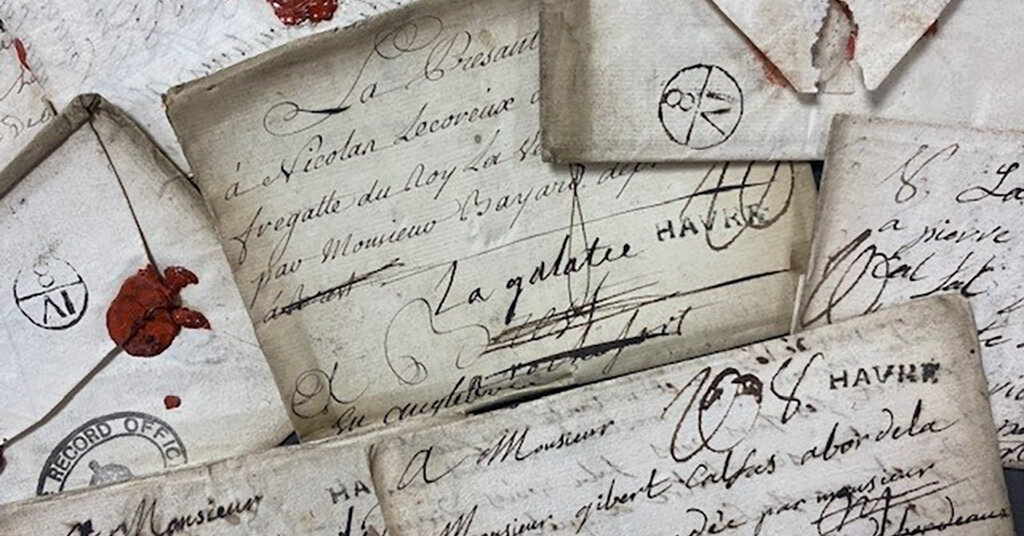The ink has barely faded, and the paper has only slightly yellowed. For nearly 250 years, the letters, more than 100 of them, sat sealed in Britain’s National Archives, unopened and unexamined until a history professor stumbled upon them. He found, to his delight, a treasure trove bearing intimate details about romance and daily life in mid-18th-century France.
Unlike many other written documents from that era, most of the letters were written by women — the mothers, fiancées and sisters of French sailors whose warship, the Galatée, was captured by the British Navy on April 8, 1758. Some letters contained accounts of wives pining for their husbands away at war, while others included discussions of household finances, the birth of a child or expressions of resentment toward sailors who had been out of touch.
Renaud Morieux, a European history professor at the University of Cambridge who discovered the collection of letters in 2004, said he asked an archivist if he could examine the contents of a box only out of curiosity while conducting research at the National Archives in southwest London.
Inside the box, Dr. Morieux found three bundles of letters. Only three of the letters had been opened, most likely by a low-level clerk shortly after the British Navy had received them from France. The clerk may have deemed them not worthy of further inspection and put them into storage, where they were forgotten about.
Dr. Morieux spent five months poring over the letters, which had been folded into envelopes and sealed with red wax stamps. The writing was scribbled onto high-quality paper and was often littered with spelling errors. Busy with writing a book and with other research projects, Dr. Morieux published his findings this week, nearly 20 years after discovering the letters, in the French academic journal Annales. Histoire, Sciences Sociales.
In one letter, a woman named Anne Le Cerf wrote to her husband, a noncommissioned officer on the ship, saying that she could not wait to “possess” him, using a word that could have meant “embrace” or “make love.” Ms. Le Cerf signed the letter, “your obedient wife, Nanette,” using an affectionate nickname. Her husband, Jean Topsent, who was imprisoned in England at that time, never received the letter.
In another, a woman writes to her husband that she could spend all night writing to him, but “I wouldn’t have space to sign.” The woman, Marie Dubosc, concluded by saying it was midnight and time for her to rest. Ms. Dubosc’s husband, the Galatée’s first lieutenant, Louis Chambrelan, never received the letter, nor would they ever meet again. Ms. Dubosc died the next year in Le Havre, France.
Letter-writing was a popular pastime in the 18th century, particularly love letters to those who were far away at war. Rebecca Earle, a history professor at the University of Warwick, said that what made this collection of letters remarkable was that they provided a rare insight into the personal lives of people in 18th-century France.
“It is really difficult to get to the emotional texture of the marriages and personal lives of ordinary people in the past,” Dr. Earle said. “That’s very hard for historians to capture.” She said the letters added to growing evidence that 18th-century women were not always shy about expressing their intimate desires to their partners.
And it wasn’t just their partners who would have read them. Dr. Morieux said that many of the people who sent the letters did not know how to read or write, so they dictated what they wanted to say to a scribe.
In another letter, Marguerite Lemoyne, the mother of a sailor, Nicolas Quesnel, wrote to her son, “I think more about you than you about me.” She asked him to give her regards to his shipmate Varin since, “it is only his wife who gives me your news.” Two months later, in February 1758, Mr. Quesnel’s fiancée, Marianne, urged him in a letter to write to his mother more frequently.
These letters were written during the Seven Years’ War, which lasted from 1756 to 1763, and is often described as the first global conflict. During the war, in which Britain and Prussia opposed France, Austria and Spain, Britain imprisoned more than 64,000 French sailors.
The French postal administration had tried to deliver the letters to multiple ports in France, but each time the Galatée had already departed. When the French authorities learned that the ship, which had been sailing from Bordeaux to Quebec, had been captured by the British Navy, they sent the letters to London. The captured ship had been taken to Plymouth, England, where the sailors disembarked and were sent to prison.
Dr. Morieux said he found it emotional to be the first person to read such messages, filled with sadness and intimacy, that went undelivered to their intended recipients. In one letter, a woman writes to her brother, a sailor, that their parents have died. She urges him not to be too sad, noting that only “death is certain.”
